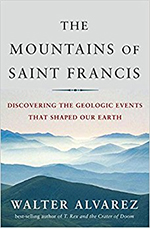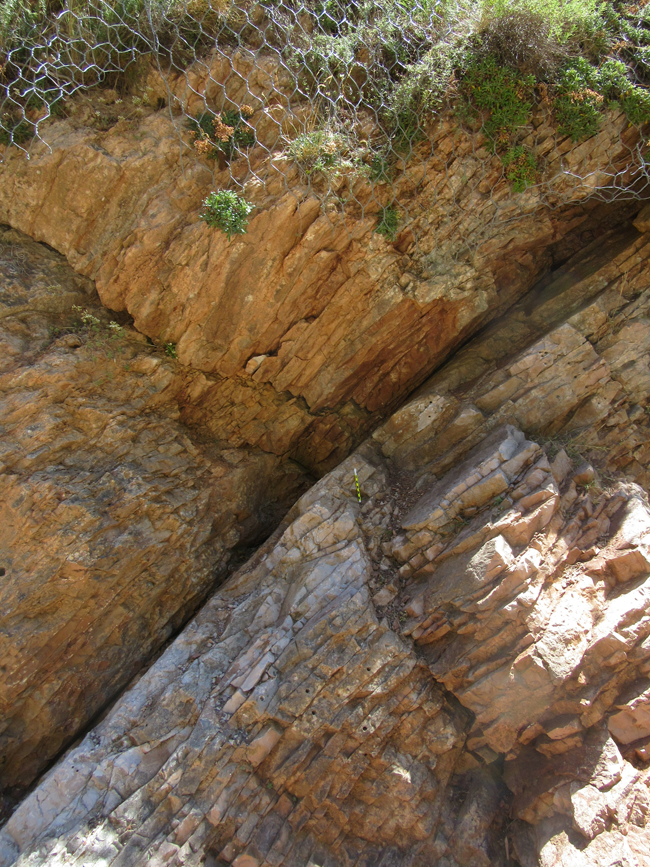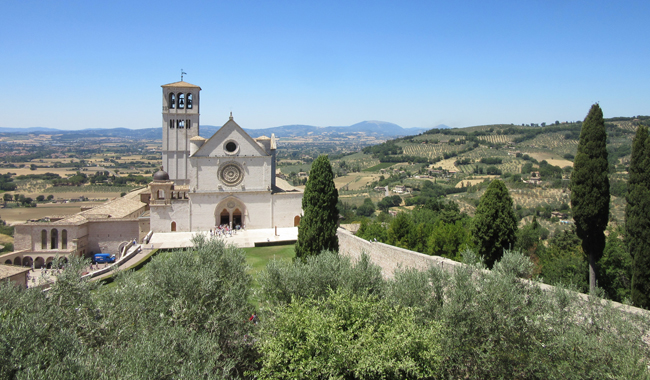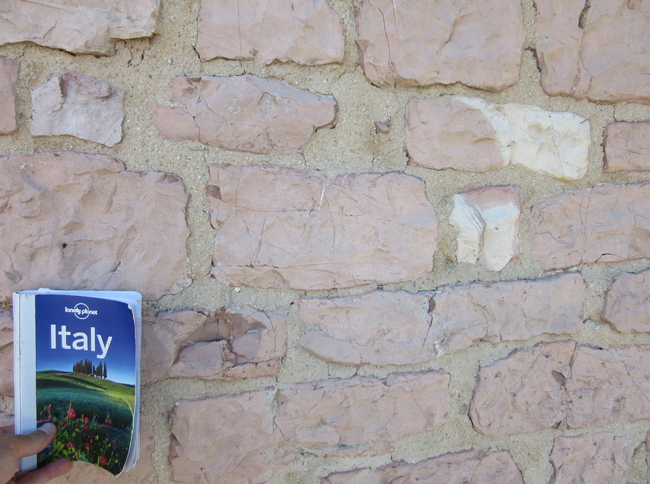18 July 2017
The Mountains of Saint Francis, by Walter Alvarez
Posted by Callan Bentley
 I’ve just finished three weeks of travel in Italy, and I was absolutely delighted to read this terrific book by Walter Alvarez while I was there. Alvarez is famous the world over for being the nucleus of the team that proposed an extraterrestrial meteorite impact as the cause of the end-Cretaceous extinction, prompted to that bold hypothesis by the discovery that the clay seam marking the boundary between the Mesozoic and Cenozoic portions of the Scaglia Rossa limestone near Gubbio (the “K/T boundary”) contained anomalously high levels of iridium. But Alvarez didn’t set out to drive a stake into the heart of uniformitarian doctrine. In his career, he hasn’t focused on mass extinctions or meteorite impacts. Instead, in The Mountains of St. Francis, he tells the story of the less celebrated aspects of his career, working on the geology of Rome, then moving afield to the Apennine Range, the mountainous “backbone” of Italy. It was in attempting to match up the foraminiferid fossil record of the Scaglia Rossa with the record of paleomagnetic reversals (The “Rossa” in Scaglia Rossa means “red,” referring to the color that results from a decent amount of magnetic iron in these strata), an important exercise in bolstering the stratigraphic toolkit, that Alvarez stumbled onto the K/T boundary iridium anomaly. Along the way, over decades of Italian fieldwork with his wife Milly and a host of colleagues, he explores basic geological concepts for the lay reader, ideas very familiar to readers of blogs like this one, but in a new, thoughtful, patient, and creative way (and therefore worth reading for that reason alone). In so doing, he makes The Mountains of St. Francis into a calm, insightful introductory text to geology: with concepts discussed ranging from superposition to to turbidites to thrust faulting to delamination to the Messinian Salinity Crisis. Foundational research in many disparate branches of geology happened in this mountain range, and Alvarez is an appreciative, contemplative guide to exploring it. The title of the book comes from St. Francis of Assisi, whom Alvarez examines in the first chapter, including the first mention of the Scaglia Rossa in describing the lovely pink limestones used to construct the Basilica of St. Francis in Assisi, where the saint is buried.
I’ve just finished three weeks of travel in Italy, and I was absolutely delighted to read this terrific book by Walter Alvarez while I was there. Alvarez is famous the world over for being the nucleus of the team that proposed an extraterrestrial meteorite impact as the cause of the end-Cretaceous extinction, prompted to that bold hypothesis by the discovery that the clay seam marking the boundary between the Mesozoic and Cenozoic portions of the Scaglia Rossa limestone near Gubbio (the “K/T boundary”) contained anomalously high levels of iridium. But Alvarez didn’t set out to drive a stake into the heart of uniformitarian doctrine. In his career, he hasn’t focused on mass extinctions or meteorite impacts. Instead, in The Mountains of St. Francis, he tells the story of the less celebrated aspects of his career, working on the geology of Rome, then moving afield to the Apennine Range, the mountainous “backbone” of Italy. It was in attempting to match up the foraminiferid fossil record of the Scaglia Rossa with the record of paleomagnetic reversals (The “Rossa” in Scaglia Rossa means “red,” referring to the color that results from a decent amount of magnetic iron in these strata), an important exercise in bolstering the stratigraphic toolkit, that Alvarez stumbled onto the K/T boundary iridium anomaly. Along the way, over decades of Italian fieldwork with his wife Milly and a host of colleagues, he explores basic geological concepts for the lay reader, ideas very familiar to readers of blogs like this one, but in a new, thoughtful, patient, and creative way (and therefore worth reading for that reason alone). In so doing, he makes The Mountains of St. Francis into a calm, insightful introductory text to geology: with concepts discussed ranging from superposition to to turbidites to thrust faulting to delamination to the Messinian Salinity Crisis. Foundational research in many disparate branches of geology happened in this mountain range, and Alvarez is an appreciative, contemplative guide to exploring it. The title of the book comes from St. Francis of Assisi, whom Alvarez examines in the first chapter, including the first mention of the Scaglia Rossa in describing the lovely pink limestones used to construct the Basilica of St. Francis in Assisi, where the saint is buried.
So the book is simultaneously a memoir of a career’s worth of research, a travel guide to Italy, an layperson’s introduction to geological thinking, and a primer on the geologic history of central Italy. It’s unique in trying to serve all these purposes simultaneously, but I think it works. It was exactly the sort of book I wanted for the sort of trip I was taking.
During my Italian travels, I visited both the K/T boundary at Gubbio and the Basilica of St. Francis in Assisi. My experiences at both places were enriched as a result of having read Alvarez’s book. If you are traveling to central Italy and you are a geologist, this is the book to read. It’s highly recommended in that case. If you have no plans to ever go to the Apennines, I’m not sure it will read quite as smoothly, as there’s lots of local flavor that may seem alien until you come to Italy yourself. With that caveat, I highly recommend it.
The K/T boundary at Gubbio:

The pink Basilica of St. Francis in Assisi:

The Scaglia Rossa exposed in Assisi’s building stones, with my Lonely Planet for scale:



 Callan Bentley is Associate Professor of Geology at Piedmont Virginia Community College in Charlottesville, Virginia. He is a Fellow of the Geological Society of America. For his work on this blog, the National Association of Geoscience Teachers recognized him with the James Shea Award. He has also won the Outstanding Faculty Award from the State Council on Higher Education in Virginia, and the Biggs Award for Excellence in Geoscience Teaching from the Geoscience Education Division of the Geological Society of America. In previous years, Callan served as a contributing editor at EARTH magazine, President of the Geological Society of Washington and President the Geo2YC division of NAGT.
Callan Bentley is Associate Professor of Geology at Piedmont Virginia Community College in Charlottesville, Virginia. He is a Fellow of the Geological Society of America. For his work on this blog, the National Association of Geoscience Teachers recognized him with the James Shea Award. He has also won the Outstanding Faculty Award from the State Council on Higher Education in Virginia, and the Biggs Award for Excellence in Geoscience Teaching from the Geoscience Education Division of the Geological Society of America. In previous years, Callan served as a contributing editor at EARTH magazine, President of the Geological Society of Washington and President the Geo2YC division of NAGT.
Callan: Thanks for the review. I enjoyed both the book and your comments.
I am an astrophysicist by background, but have fallen in love with Italy and all of its wonderful features many yrs ago. I thoroughly enjoyed the Mountains of St Francis and have gone to many of the sites near Gubbio mentioned in Alvarez’ book.